The Galapagos Islands are a year-round destination. While each month has its own rewards, our experts agree that the best time to visit the Galapagos Islands is from December to May.
Why? These months coincide with the warm season and ocean conditions are clear, warm excellent for snorkeling and diving. Brief tropical showers interrupt bright sunny days keeping vegetation green and wildlife active. Alternatively, from June to November, cooler nutrient-rich ocean currents create an arid maritime influence. In the cool season tropical showers are replaced by fog and trade winds can cause choppy seas, but this is an excellent time for hiking and viewing active marine life.
Read on for the benefits of each month to get you thinking about the best time to go to Galapagos.

IN THE KNOW ON
WHEN TO GO
Expert insights,
delivered to your inbox.
IN THIS POST – The Best Time to Visit Galapagos:
Galapagos Weather & Climate
Galapagos Islands Seasons
Galapagos Warm Season:
– Dec, Jan, Feb, Mar, Apr, May
Galapagos Cool Season:
– Jun, Jul, Aug, Sep, Oct, Nov
Galapagos Water Temperature
Snorkeling Seasons
Galapagos Ocean Conditions
Packing For Galapagos
El Nino & La Nina
Daylight Hours & Time Zone
When is Your Best Time to Visit?
More Galapagos Resources
Galapagos by Month: When To Go & Why
This Galapagos month by month guide is designed to help you determine the best month to visit Galapagos Islands. It outlines Galapagos monthly weather, water temperatures and Galapagos wildlife by month. It also answers questions such as “What is Galapagos weather in December?” and “What is the best time to visit Galapagos for wildlife?” and of course “What is the best time to visit the Galapagos Islands?” We strive to give you detailed information to answer these questions based on your own travel timing and interests.
Galapagos Weather & Climate Overview
Galapagos Islands weather is pleasant year round and influenced largely by ocean currents. The islands are located on the equator and the weather does not change significantly throughout the year, though there are seasonal variations. Galapagos Islands temperature ranges from lows in the 60’s Fahrenheit (16 Celsius) to highs in the 90’s Fahrenheit (32 Celsius). Rain and fog can occur seasonally, and wind can be a factor influencing ocean conditions. Learn more about Galapagos climate and view our Galapagos Islands climate and water temperature table below.
FIND GALAPAGOS TRIPS
See the full list of itineraries by ship and on land.
Galapagos Islands Weather
Temp, Rainfall & Water Averages
| Month | Jan | Feb | Mar | Apr | May | Jun | Jul | Aug | Sep | Oct | Nov | Dec |
|---|---|---|---|---|---|---|---|---|---|---|---|---|
| Avg. High (F) | 84 | 86 | 88 | 86 | 82 | 78 | 76 | 74 | 76 | 77 | 78 | 80 |
| Avg. Low (F) | 70 | 74 | 77 | 72 | 72 | 68 | 66 | 64 | 62 | 64 | 66 | 68 |
| Avg. Water Temp (F) | 74 | 76 | 76 | 76 | 74 | 74 | 72 | 66 | 68 | 70 | 72 | 74 |
| Avg. Rain |
2.0 | 2.6 | 3.3 | 1.4 | 0.6 | 0.1 | 0.2 | 0.2 | 0.3 | 0.3 | 0.2 | 0.3 |
Galapagos Islands Seasons in Detail
Galapagos Island weather is divided into two distinct seasons, the “warm” season occurs December through May and the “cool” season occurs June through November. Warm and cool are relative since temperatures are always quite warm. Since the islands are suitable for travel year round, there is no true high season or low season. There is no Galapagos Islands hurricane season as hurricanes do not occur here.
Best Time to Avoid the Crowds in Galapagos
Visitation is highest during Christmas, Easter and Spring Break holidays; and during the summer when kids are out of school. This is when prices are highest and Galapagos vacations and Galapagos small ship cruises must be booked in advance. The best time to avoid crowds in Galapagos, and the best time to score a Galapagos deal, are early December, just before the holiday; early January, just after the holiday; and in September after the summer season is over.
Galapagos Shoulder Seasons
Visiting Galapagos during the crossover between warm and cool seasons in May and November can result in the best of both worlds. Shoulder seasons can result in great weather, ideal ocean conditions and relatively few people. The shifting currents means changing food sources for animals which can result in interesting wildlife encounters. We think that the May and November shoulder seasons are a great time to visit the Galapagos.
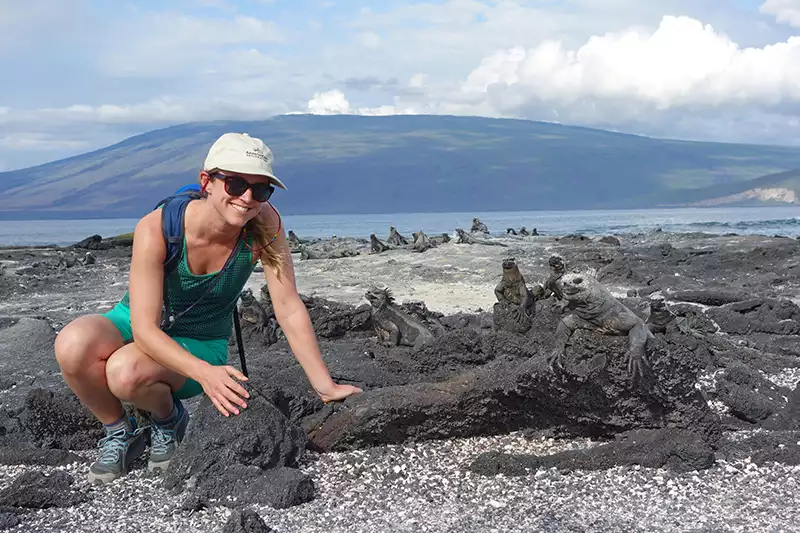
PICTURE YOURSELF HERE
1-on-1 consultation.
Start planning today.
Galapagos Warm Season (Rainy Season Galapagos)
The Galapagos warm season (also known as rainy season Galapagos or green season) occurs from December through May. This time of year, Galapagos temperature ranges from the 70’s to upper 80’s Fahrenheit (21-27 Celsius).
During the warm season, the northern Panama current heats the water temperature to the mid-70’s Fahrenheit (21 Celsius). This brings sunny hot days and periodic rains. Rain typically arrives in the afternoon and often clears up by evening. The rainy season in Galapagos brings the desert landscape to life with lush green leaves providing an abundance of food for terrestrial animals.
Ocean conditions are calmer during the warm season, resulting in excellent underwater visibility and incredible snorkeling accessed by Galapagos cruises. December through May are the best months for snorkeling. Consider the warm season if you are concerned about seasickness.
December in Galapagos
December marks the beginning of the warm season, characterized by temperate calm water, increased rain and hotter temperatures. As December progresses, the misty fog of Garua season dissipates, replaced by tropical rains and hot sun. Visiting the Galapagos in December is distinguished between early December and the holiday season. Early December is uncrowded and a good time for Galapagos deals. The December Christmas and New Year’s holiday season is the busiest time in the Galapagos and advanced reservations are required.
Galapagos Weather in December:
- Galapagos temperature in December: 68-80 degrees Fahrenheit | 20-27 Celsius
- Average Galapagos water temperature in December: 74 degrees Fahrenheit | 23 Celsius
- Average Galapagos rainfall in December: 0.3 Inches | 1 Centimeter
Galapagos Travel in December:
- Early December is uncrowded and Galapagos deals maybe available
- The Christmas and New Year’s holiday season is busy and advanced reservations are required
- The rainy season begins, and plants of the dry zone produce leaves turning the landscape green again.
Galapagos Wildlife in December:
- Hatching of giant tortoise eggs begins and lasts until April
- Green sea turtles display their mating behavior
- Marine and land iguanas begin mating season
- The first young waved albatrosses fledge
January in Galapagos
Visiting Galapagos in January means holiday crowds are gone and the subsequent lull in travel results in some Galapagos deals. Warm currents from the north have shifted. Dry season fog and tradewinds are replaced by warmer temperatures, periodic tropical rain and humidity. The Galapagos warm season begins in January. Early rains signal birds and iguanas to begin nesting and mating. In January, the water is clear with excellent visibility. Galapagos SCUBA season begins and snorkeling is excellent.
Galapagos Weather in January:
- Galapagos temperature in January: 70-84 degrees Fahrenheit | 21-29 Celsius
- Average Galapagos water temperature in January: 74 degrees Fahrenheit | 23 Celsius
- Average Galapagos rainfall in January: 2.0 Inches | 5 Centimeters
Galapagos Travel in January:
- Holiday crowds are gone and Galapagos deals may be available
- Both water and air temperatures rise and stay warm until June
- Ideal time for snorkeling
- Excellent bird watching
Galapagos Wildlife in January:
- Land birds start nesting, generally after the first rain
- On Española Island adult marine iguanas become brightly colored (green & red + black)
- The green sea turtles arrive to beaches for egg-laying period
- Land iguanas begin reproductive cycles on Isabela Island

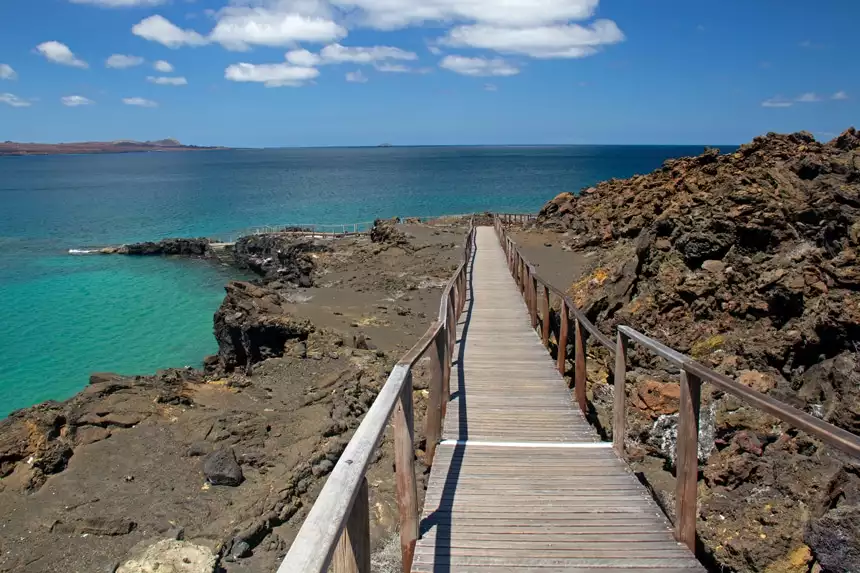
February in Galapagos
Galapagos in February is characterized by hot, humid days and clear, calm water. Tropical rains are expected but you will dry out quickly when the sun inevitably comes out. February is known for the best underwater visibility and is the height of the SCUBA diving season. Consistently calm water and calm winds usually means seasickness is not an issue.
Galapagos Weather in February:
- Galapagos temperature in February: 70-86 degrees Fahrenheit | 21-30 Celsius
- Average Galapagos water temperature in February: 76 degrees Fahrenheit | 24 Celsius
- Average Galapagos rainfall in February: 2.6 Inches | 7 Centimeters
Galapagos Travel in February:
- The highest water temperatures continue February through April
- Calm, clear water excellent for snorkeling
- Great time for kayaking and glass-bottom boats (for ships that offer them)
- Time your trip with Carnival on mainland Ecuador
Galapagos Wildlife in February:
- On Floreana Island greater flamingos start nesting
- Bahama pintail ducks (black-tailed pintail) start their breeding season
- Nazca (masked) boobies on Española Island are at the end of their nesting season
- Marine iguanas nest on Santa Cruz Island
- Penguin sightings are rare on Bartolome Island as most have followed the cool waters to the west
- Nesting season of the Galapagos dove reaches its peak
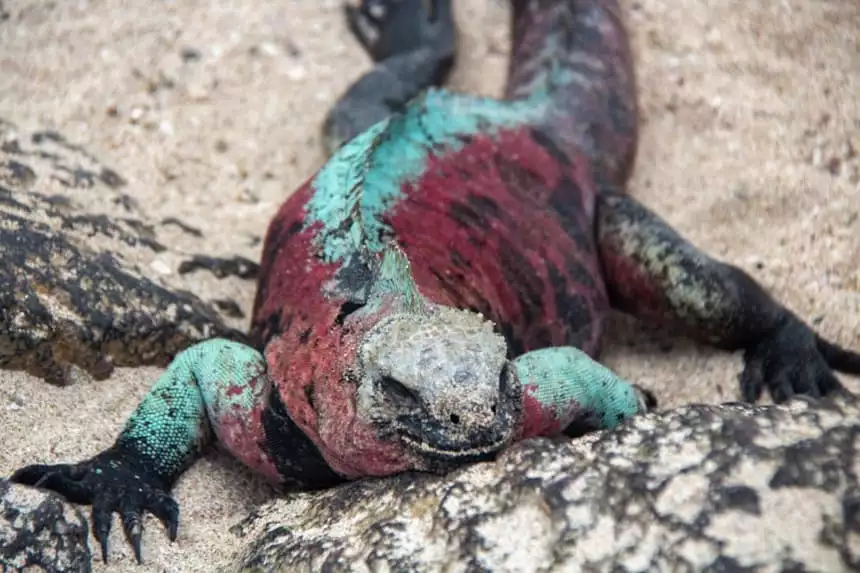



March in Galapagos
Visiting the Galapagos in March means the warmest time of year. March is the peak of the Galapagos rainy season, but this does not mean it rains every day or all the time. Periodic tropical rain, intense sun and hot humid weather persists. Average temperature is in the upper 80’s and will reach the 90’s when the sun is out. This time of year feels the most tropical in the Galapagos. Pack your sunscreen and cool shirts in March.
Galapagos Weather in March:
- Galapagos temperature in March: 77-88 degrees Fahrenheit | 25-31 Celsius
- Average Galapagos water temperature in March: 76 degrees Fahrenheit | 24 Celsius
- Average Galapagos rainfall in March: 3.3 Inches | 8 Centimeters
Galapagos Travel in March:
- March is the warmest month in the Galapagos
- Even the western islands have warm waters where snorkeling is excellent
- Punta Vicente Roca near Isabela Island can be an amazing snorkeling site
- Due to warmer water temperatures, snorkelers may remain longer periods of time in the water
- Spring Break and Easter Holidays are busy, book early for these dates
- North-facing shores can receive strong northern currents. Wet landings at places like Puerto Egas, Gardner Bay and Bartolome can sometimes be a challenge
Galapagos Wildlife in March:
- The height of the rainy season brings lush green vegetation and food for animals
- Marine iguanas nest on Fernandina
- March 21st, the March equinox, signals the arrival of the waved albatross to Española
- Punta Vicente Roca near Isabela Island can be an amazing snorkeling site with penguins still active in the water next to tropical fish!
April in Galapagos
Visiting the Galapagos in April marks the end of the rainy season. Rains diminish throughout the month. The normally arid coastline is lush with green vegetation. Birds and animals are feasting on plants and seeds. Temperatures remain hot and good underwater visibility continues. April is a popular month for Galapagos tours.
Galapagos Weather in April:
- Galapagos temperature in April: 72-88 degrees Fahrenheit | 22-30 Celsius
- Average Galapagos water temperature in April: 76 degrees Fahrenheit | 24 Celsius
- Average Galapagos rainfall in April: 1.4 Inches | 4 Centimeters
Galapagos Travel in April:
- While the rains have ended, the islands are still quite green and lush.
- Spring Break and Easter Holidays are busy, book early for these dates.
- Good visibility in the water for snorkelers
- April is among the best months in Galapagos in terms of weather, animals and water temperature.
Galapagos Wildlife in April:
- Massive arrival of waved albatrosses to Española Island where the amazing courtship starts
- End of hatching season for the giant tortoises
- Eggs of green sea turtles begin to hatch and babies emerge
- Eggs of land iguanas hatch on Isabela Island
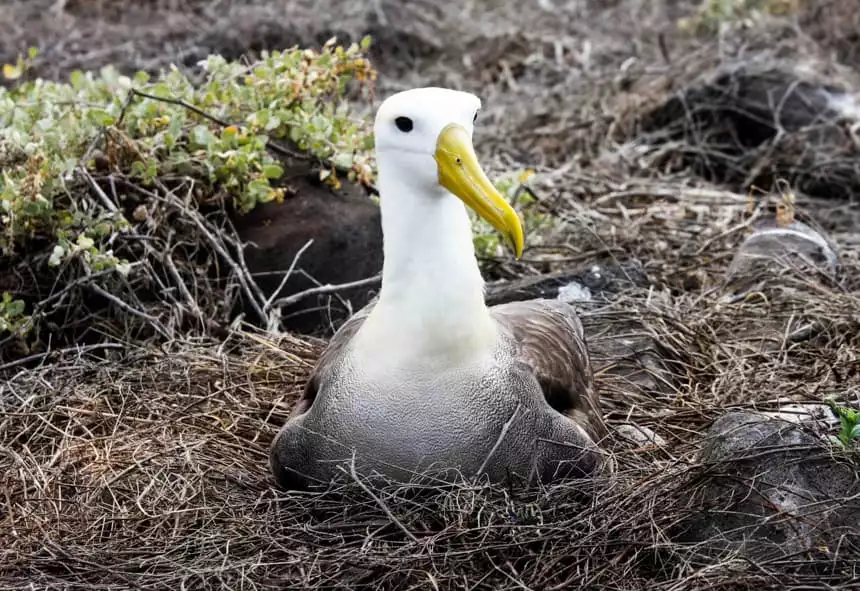
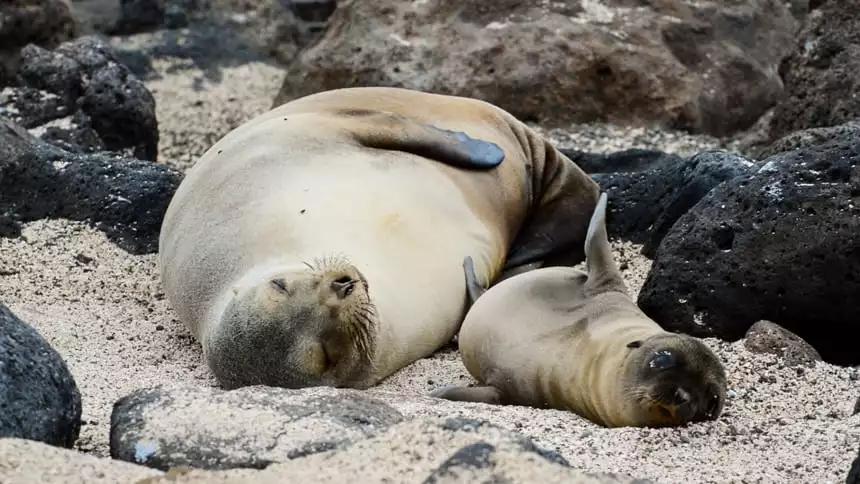

May in Galapagos
Visiting the Galapagos in May, the weather is warm but not too hot. The water is warm and clear. There is a great variety of animals and they are active. May is the transition time between the warm season and the cool season. The summer Galapagos travel season has not started so it is not too crowded. Some will argue that May is the best month to visit the Galapagos Islands.
Galapagos Weather in May:
- Galapagos temperature in May: 72-82 degrees Fahrenheit | 22-28 Celsius
- Average Galapagos water temperature in May: 74 degrees Fahrenheit | 23 Celsius
- Average Galapagos rainfall in May: 0.6 Inches | 2 Centimeters
Galapagos Travel in May:
- Transition between warm and cool season results in dynamic weather and wildlife
- Terrestrial and marine life are active
- In terms of weather, animals and water temperature, May is the best time to visit the Galapagos.
Galapagos Wildlife in May:
- North Seymour’s blue-footed boobies begin their courtship
- Sea turtles are still hatching on Gardner Bay, Punta Cormorant and Puerto Egas
- Most of marine iguanas’ eggs hatch from nests on Santa Cruz
- Palo santo trees begin to shed their foliage
- Waved albatross on Española start laying their eggs
- Ban-rumped storm petrels begin their first nesting period
- Galapagos penguins at Bartolome are active at the surface or torpedo-like while underwater
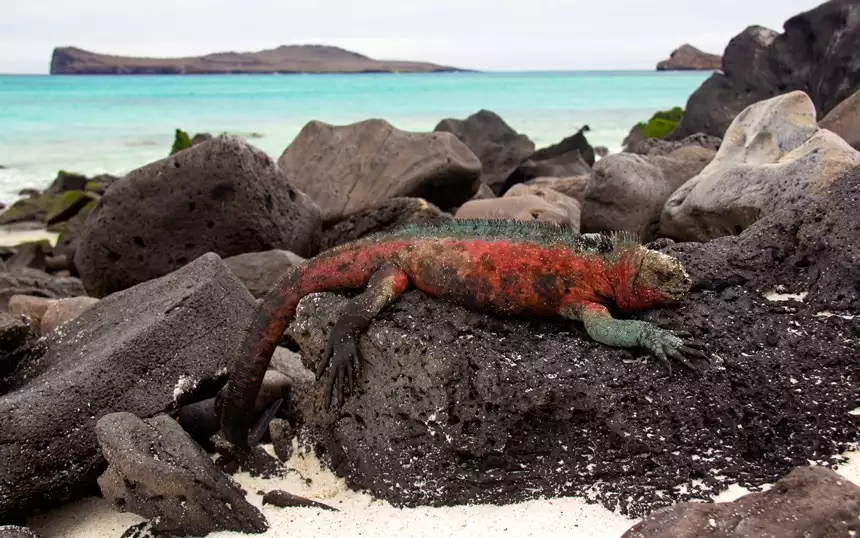
Galapagos Cool Season (Galapagos Dry Season)
The Galapagos cool season (also known as the Galapagos dry season or Garua season) occurs from June through November. This time of year, Galapagos average temperatures range from the mid 70’s Fahrenheit (21 Celsius) to the low 60’s Fahrenheit (16 Celsius).
During the cool season, the southern Humboldt and Peru currents cool the water temperature to as low as 66 Fahrenheit (19 Celsius). This brings cooler days and a persistent misty fog known as Garua, especially in the highlands. Rain is uncommon during the cool season.
During the cool season tradewinds increase, causing the ocean to be choppier. Underwater visibility is decreased, but still excellent for snorkeling. A wetsuit may be required for underwater activities. The cold current and tradewinds cause mixing which brings a bloom of life to the oceans, making marine life explode. This is the best season to view penguins, dolphins, whales, and other large marine animals.
June in Galapagos
Visiting the Galapagos in June marks the beginning of the cool season. The cool Humboldt and Peru currents from the south have overpowered the warm Panama current from the north. Temperatures are still warm, but not as hot and humid. June marks the beginning of the Garua season characterized by marine fog, mist and drizzle. The sun still shines but it can be foggy in the morning and evening. Tradewinds can result in choppy seas. Snorkeling is still excellent, but visibility is reduced.
Galapagos Weather in June:
- Galapagos temperature in June: 68-78 degrees Fahrenheit | 20-26 Celsius
- Average Galapagos water temperature in June: 74 degrees Fahrenheit | 23 Celsius
- Average Galapagos rainfall in June: 0.6 Inches | 2 Centimeters
Galapagos Travel in June:
- Beginning of busy summer travel season popular with families
- Beginning of the Garua season
- Cooler weather makes hiking enjoyable
- Southeast tradewinds return and currents become a bit stronger
- Seas pick up in surge and wave action
- Excellent bird watching
Galapagos Wildlife in June:
- Giant tortoises on Santa Cruz Island migrate from the highlands to the lowlands in search of suitable nesting places
- Beginning of the nesting season of giant tortoises
- The male magnificent frigatebirds on North Seymour start flaunting their red pouches
- Southern migrant birds have started their journey toward the north and Galapagos is a rest stop for such birds
- Some species of whales and dolphins also follow this pattern of migration
- Groups of humpback whales that migrate up to equatorial latitudes along the coast of Ecuador can reach the Galapagos

July in Galapagos
Visiting the Galapagos in July marks the beginning of the summer travel season. The temperature is considerably cooler. You may need a wetsuit when snorkeling and a jacket for cool evenings. Tradewinds increase and rough waters can make seasickness a concern on interisland crossings (see How to Prevent & Treat Seasickness on Cruises). Life in the ocean is exploding, creating a bounty for marine animals and seabirds. Galapagos family cruises and tours are available. Summer cruises book far in advance so plan ahead.
Galapagos Weather in July:
- Galapagos temperature in July: 66-76 degrees Fahrenheit | 19-24 Celsius
- Average Galapagos water temperature in July: 72 degrees Fahrenheit | 22 Celsius
- Average Galapagos rainfall in July: 0.2 Inches | 1 Centimeter
Galapagos Travel in July:
- Busy summer travel season popular with families
- Cooler weather makes hiking enjoyable
- Cooler water requires a wetsuit
- Active marine life makes snorkeling excellent
Galapagos Wildlife in July:
- Seabird communities are very actively breeding, especially the blue-footed boobies on Española Island.
- Flightless cormorants perform beautiful courtship rituals and nesting activities on Fernandina
- Oystercatchers nest along the shores of Puerto Egas, Santiago Island.
- Lava lizards initiate mating rituals until November
- Whales and dolphins are more likely to be observed, especially off the western coast of Isabela Island.
- Great month to see the four stages of nesting in blue-footed boobies: eggs, chicks, juveniles and subadults
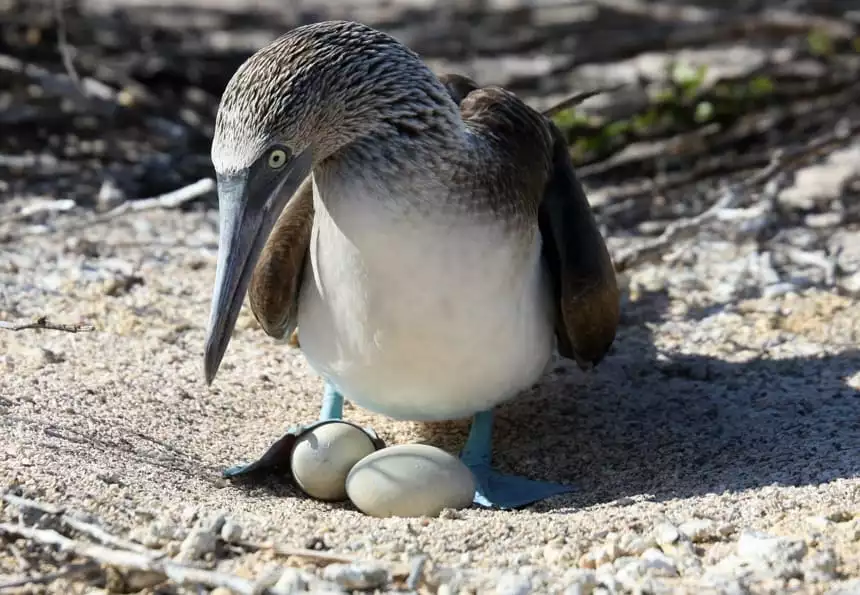
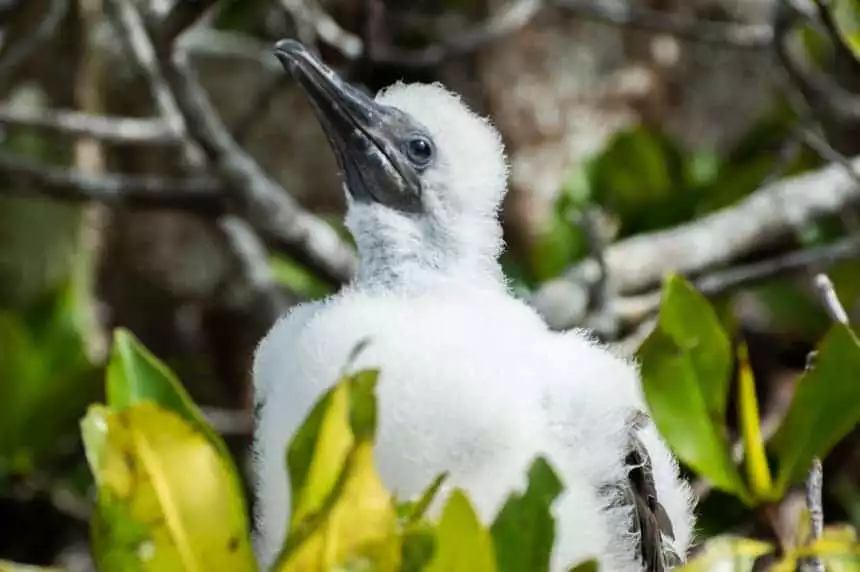

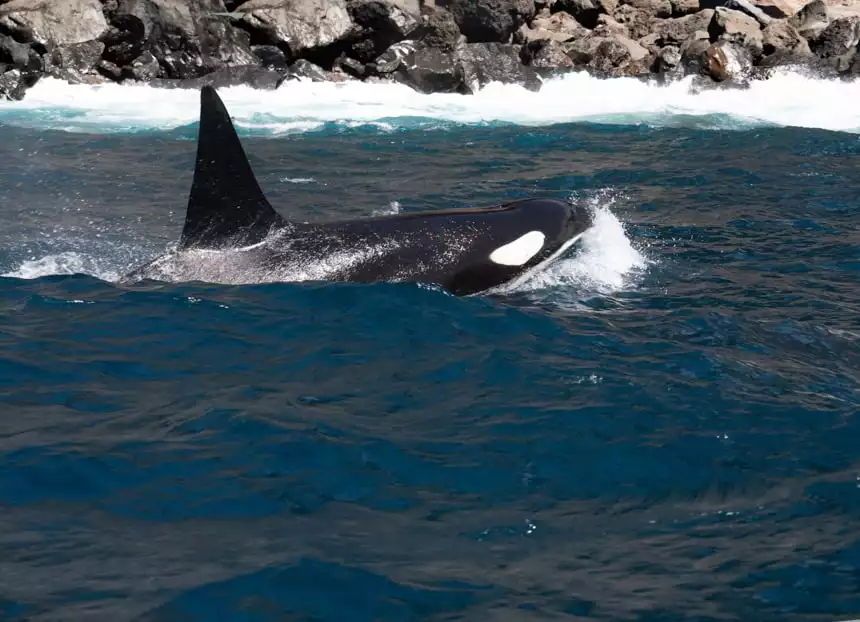
August in Galapagos
Visiting the Galapagos in August is for travelers seeking cool dry weather. Skies alternate between sun and fog. August is an active month for wildlife on land, in the skies and under the sea. The busy summer travel season concludes as kids return to school.
Galapagos Weather in August:
- Galapagos temperature in August: 64-74 degrees Fahrenheit | 18-23 Celsius
- Average Galapagos water temperature in August: 66 degrees Fahrenheit | 19 Celsius
- Average Galapagos rainfall in August: 0.2 inches | 1 Centimeter
Galapagos Travel in August:
- Cooler weather makes hiking enjoyable
- Coldest ocean temperatures of the year but can vary considerably throughout the islands
- Seas can be choppy with currents at their strongest levels, surge can be expected along the shores that face west or south.
- End of busy summer travel season
Galapagos Wildlife in August:
- Galapagos hawks court on Española and Santiago
- Nazca (masked) boobies and swallow-tailed gulls nest on Genovesa Island
- Migrant shore birds start to arrive and stay on the islands until March
- Giant tortoises return to the highlands of Santa Cruz
- The main birthing season of sea lions begins, although pups may be seen throughout the year. Western and central islands are common places for such sightings.

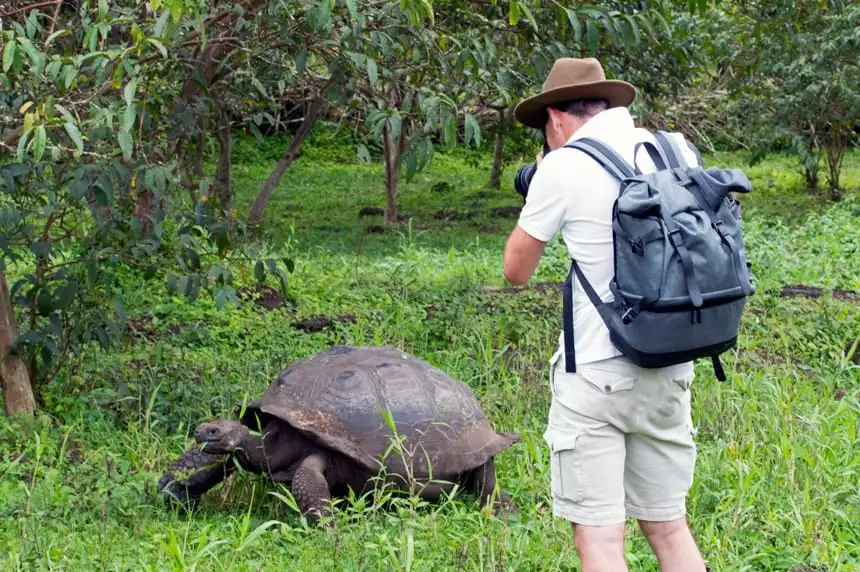
September in Galapagos
Visiting the Galapagos in September means little rain and the coolest temperatures of the year, although conditions are still quite pleasant. Marine animals are especially active including whales, dolphins, sea lions and Galapagos fur seals. September is the best time to view Galapagos penguins. Summer crowds are gone and kids are back in school, making September the best month for Galapagos deals. Some would say that September is the Galapagos low season, so some small ships and yachts come out of service for annual maintenance.
Galapagos Weather in September:
- Galapagos temperature in September: 62-76 degrees Fahrenheit | 17-24 Celsius
- Average Galapagos water temperature in September: 68 degrees Fahrenheit | 20 Celsius
- Average Galapagos rainfall in September: 0.3 inches | 1 Centimeter
Galapagos Travel in September:
- September is the coolest month in the Galapagos.
- Peak of the cool Garua season
- Summer crowds are gone and Galapagos deals may be available
- Marine life especially active
- Some vessels out of service
Galapagos Wildlife in September:
- The air temperature reaches its lowest levels
- Galapagos penguins show remarkable activity on Bartolome Island
- Sea lions are very active with harem-gathering males constantly barking and fighting. Pups still being born.
- Shore fighting by sea lions is heavy. Western and central islands are the most active islands for this.
- Most species of seabirds remain quite active at their nesting sites

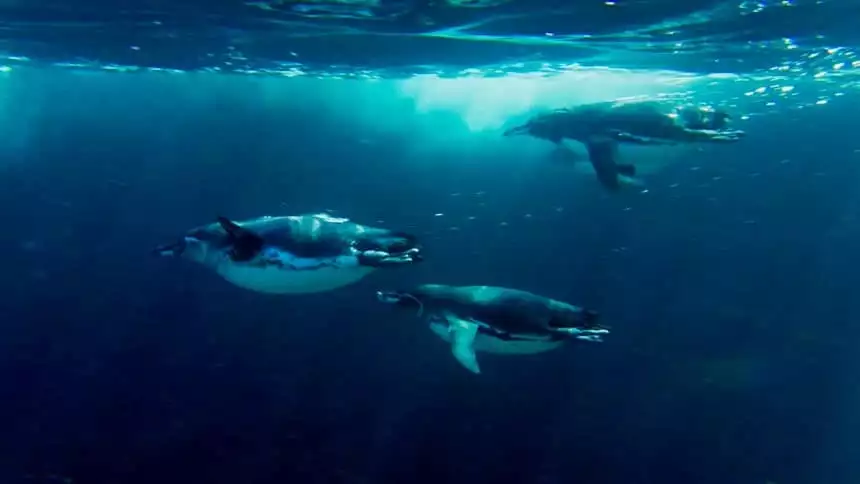

October in Galapagos
Visiting the Galapagos in October is cool and dry, but temperatures are rising again. The ocean is still cool and southern currents bring rich nutrients to feed the diverse ecosystem of the Galapagos Islands. There are few crowds in the October off season so it’s a great time for deals.
Galapagos Weather in October:
- Galapagos temperature in October: 64-77 degrees Fahrenheit | 18-25 Celsius
- Average Galapagos water temperature in October: 70 degrees Fahrenheit | 21 Celsius
- Average Galapagos rainfall in October: 0.3 inches | 1 Centimeter
Galapagos Travel in October:
- Days are not always sunny. Garua can be expected in most locations, except the western islands where most days have a misty start but after a few hours of daylight it burns off.
- Sunrises in the west can be quite beautiful as the Garua covers only certain locations of the western volcanoes. Summits are clear, but low-lying fog covers the shoreline.
Galapagos Wildlife in October:
- Lava herons start nesting until March
- The Galapagos fur seals begin their mating period
- Blue-footed boobies raise chicks all over Española and Punta Vicente Roca (Isabela)
- Giant tortoises are still laying eggs
- Pupping of sea lions continues

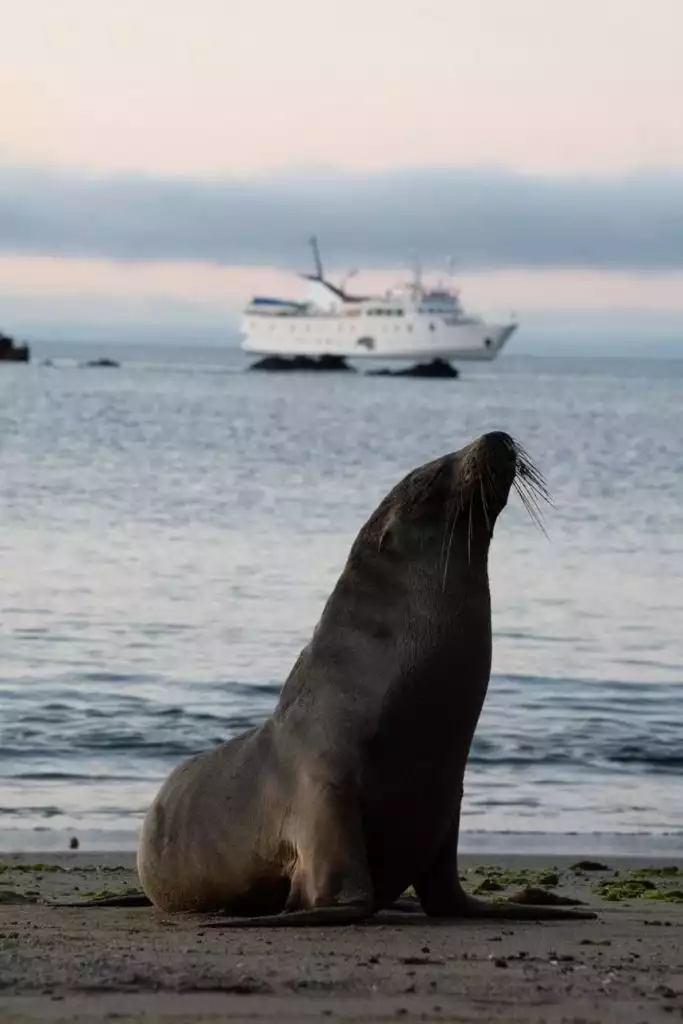
November in Galapagos
Visiting Galapagos in November can be the best of both seasons as currents begin the transition from cool to warm season. Air and water temperatures are rising and animals are active. Weather is still dry and misty but winds are decreasing as the first signs of the warm season arrive. Thanksgiving holiday in the U.S. is very busy, but otherwise November is not crowded.
Galapagos Weather in November:
- Galapagos temperature in November: 66-78 degrees Fahrenheit | 19-26 Celsius
- Average Galapagos water temperature in November: 72 degrees Fahrenheit | 22 Celsius
- Average Galapagos rainfall in November: 0.2 Inches | 1 Centimeter
Galapagos Travel in November:
- Generally great weather due to transition between cool and warm seasons
- Good water visibility for snorkeling
- Seas are calm as southeast tradewinds have decreased strength, allowing the water temperatures to slowly rise.
- Galapagos deals may be available outside of the U.S. Thanksgiving holiday
Galapagos Wildlife in November:
- Sea lions are sexually active on the eastern part of the archipelago
- Breeding season for the brown noddies
- Some species of jellyfish can be seen around the islands
- Band-rumped storm petrels begin their second nesting period
- Sea lion pups, especially at Champion Islet, play aqua-aerobics and nibble at fins of snorkelers.
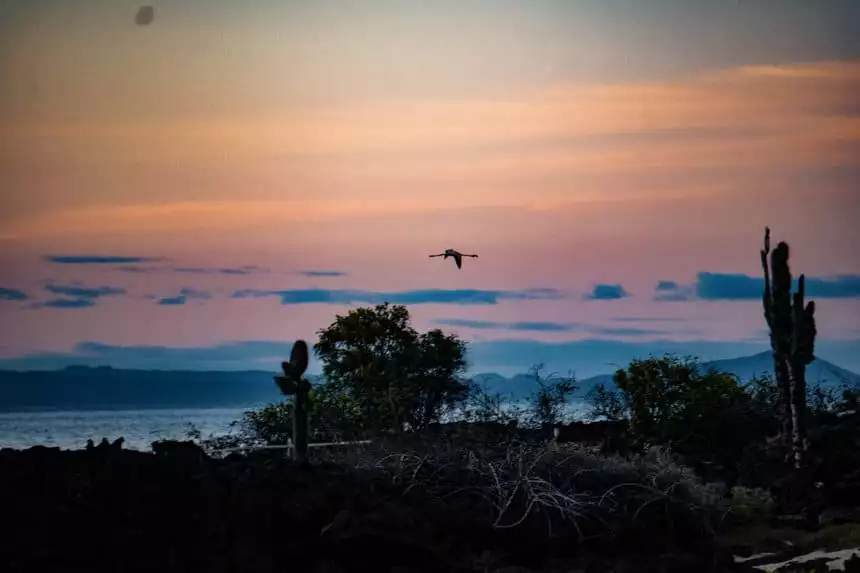
Galapagos Water Temperature
Is the water warm in the Galapagos? Water temperature in the Galapagos Islands ranges from 66-76 degrees Fahrenheit (19-24 degrees Celsius). The warmest Galapagos water temperatures occur from December through May. From June through November Galapagos water temperatures are cooler. Galapagos water temperature is greatly influenced by seasonal ocean currents.
Galapagos Snorkeling Seasons
Snorkeling is incredibly popular in the Galapagos. We encourage all travelers to get underwater to view the wildlife. If you only stay on shore you are missing an important part of the Galapagos experience.
Snorkeling in the Galapagos is known for large and rare marine life. We like to call it “charismatic megafauna.” There are schools of colorful tropical fish, starfish, sea cucumbers and other typical undersea inhabitants. But large animals such as sea lions, sea turtles, spotted eagle rays, reef sharks, marine iguanas and even penguins make snorkeling in the Galapagos unique.
As noted above, Galapagos snorkeling is excellent year round. Water temperatures and clarity are highly influenced by ocean currents. The Galapagos snorkeling season is divided into two categories: warm and cool.
Galapagos Warm Season Snorkeling
The warm snorkeling season occurs December through May and is characterized by warm, clear water. Galapagos warm season average water temperatures range from 74-76 degrees Fahrenheit (23-24 Celsius) and you may be able to snorkel without a wetsuit. During this time underwater visibility is astounding and ranges from 40-100 feet (12-33 meters).
Galapagos Cool Season Snorkeling
The cool snorkeling season occurs June through November and is characterized by cooler, nutrient-rich water. Water temperatures range from 66-72 degrees Fahrenheit (19-22 Celsius) and you will probably need a wetsuit to stay in the water long enough to snorkel. During this time underwater visibility ranges from 30-70 feet (10-21 meters) or occasionally less, but is still excellent by most standards.
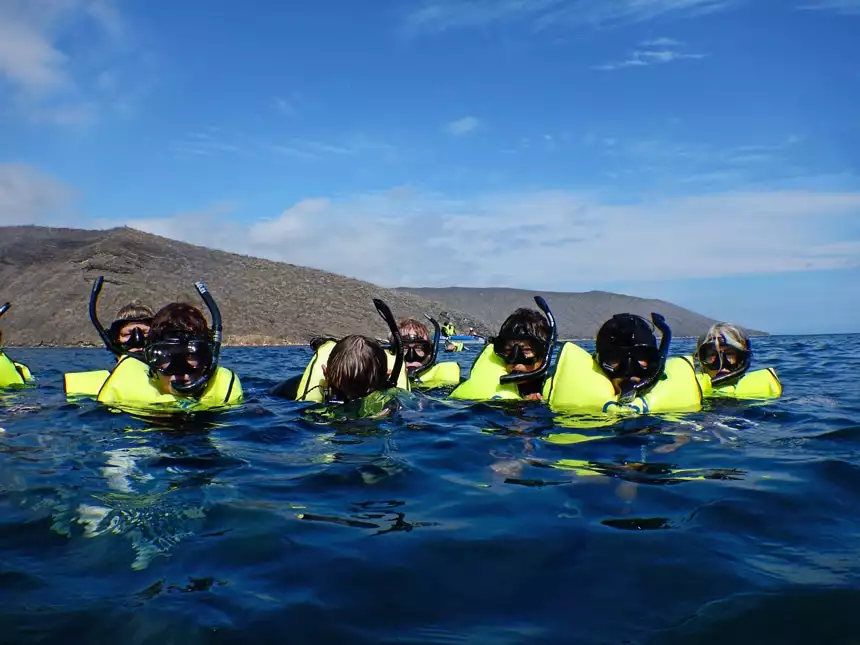
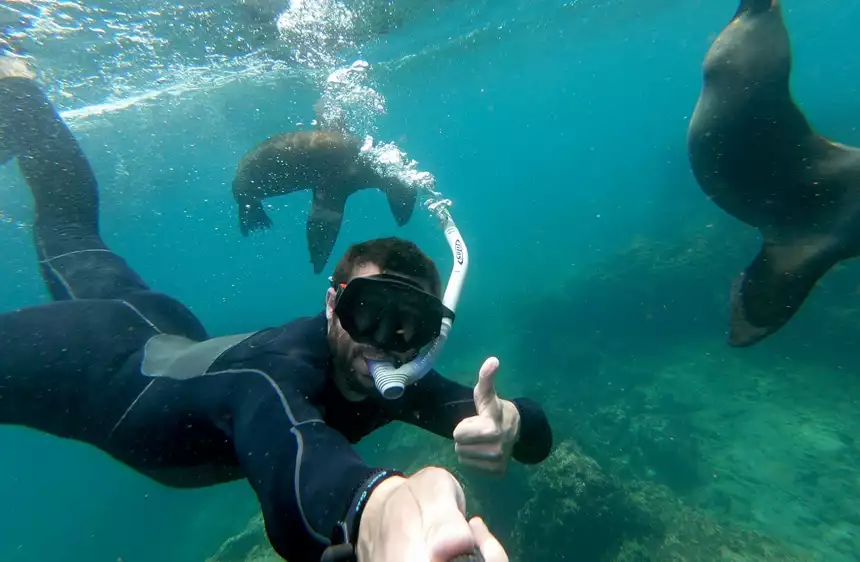
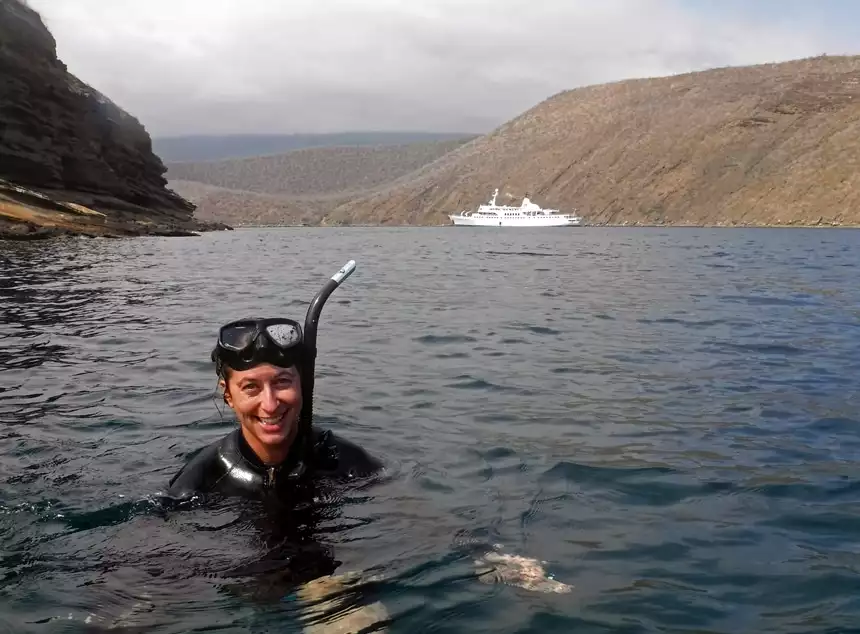
Galapagos Ocean Conditions & Seasickness
Just like Galapagos seasons, ocean conditions are almost entirely influenced by ocean currents. Increased trade winds during the Galapagos cool season, June through November, cause increased chop which can rock Galapagos cruise ships and cause seasickness.
Keep in mind that you are usually cruising close to islands which serve to protect from rougher seas. On a standard 8-day Galapagos small ship cruise, expect to make 2-4 open water crossings between islands. During such crossings you may encounter rough swells over the course of 4-6 hours of travel. It is rare to encounter truly stormy conditions but swells can cause rocking during open water crossings. Consider the warm season if you are extremely sensitive to motion. Learn How to Prevent & Treat Seasickness on Cruises.
Packing for Galapagos Travel
Weather in the Galapagos is warm and mild year round, making packing easy. Slight difference in seasons will influence what you bring. We have developed comprehensive Galapagos planning guides for our booked clients, with expertise culled from years of traveling and working in the Galapagos Islands. If you are wondering what to wear in the Galapagos in July or what to pack for Galapagos in April, consider booking with experts like us.
Protection from the intense equatorial sun is important. High SPF sunscreen, long-sleeve shirts and pants and head protection are critical. During the cool season you will want extra layers and wind protection, especially if on a Galapagos cruise. Many travelers pack a wetsuit for snorkeling although this is provided aboard most cruises. With proper planning and a well-packed suitcase, you will make the most of your Galapagos vacation any time of year.
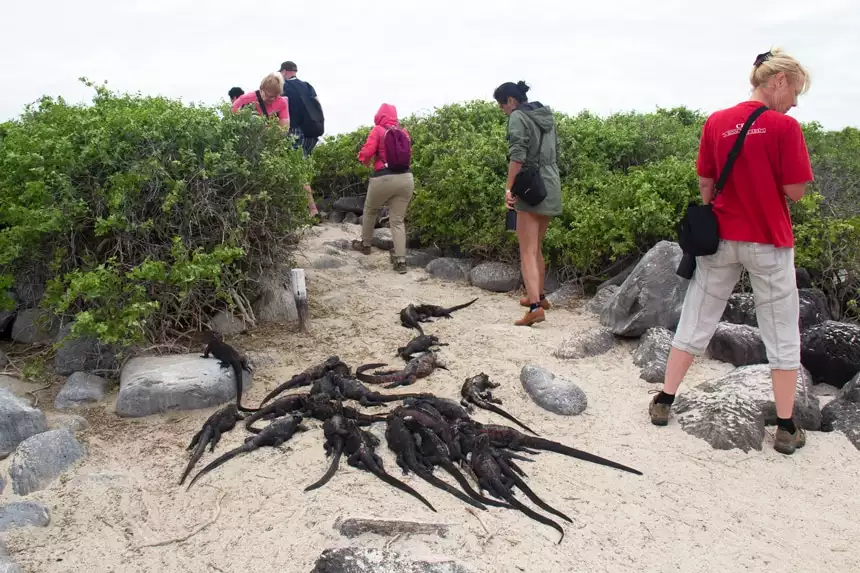

El Nino and La Nina in Galapagos
El Nino and La Nina are complex weather patterns that can affect climate in the Galapagos Islands. They are the result of warming or cooling of ocean temperatures in the Equatorial Pacific, beyond the currents that influence seasonal weather in the Galapagos. Impacts are long term, typically lasting 9-12 months or even years. While El Nino and La Nina can impact Galapagos climate, we advise travelers to not concern themselves when planning travel. The frequency of these events is quite irregular, and impacts are notoriously unpredictable. If you find yourself in the Galapagos during an El Nino or La Nina event, then consider yourself lucky and enjoy the dynamic nature of the global systems that make this place so unique.
Daylight Hours in the Galapagos
The equator runs right through Ecuador and the Galapagos Islands. As such, days are nearly uniform with 12 hours of daylight and 12 hours of darkness year round. Sunrise in Galapagos occurs between 6:00am and 6:15am year round. Sunset in Galapagos occurs between 6:00pm and 6:15pm year round. Be on deck early each evening to catch that sunset photo. There is very little dusk and the sun goes down fast.
Galapagos Time Zone
Galapagos time, or the GALT Galapagos Time Zone is 6 hours behind Coordinated Universal Time (UTC). It corresponds with Central Standard Time in North America. Galapagos time is one hour behind mainland Ecuador and New York City. Note that many Galapagos boats utilize “mainland” time keeping the same clocks as mainland Ecuador.


Checking Galapagos Weather Before Your Trip
Many travelers incessantly check the Galapagos weather forecast as their trip approaches. We encourage you to resist this temptation, it can drive you crazy. Local weather forecasts in the Galapagos are vague and inaccurate. Galapagos weather changes by the hour. Checking daily weather forecasts does little to help you prepare.
To be prepared stick to the Galapagos weather by month guidelines above and follow the advice of your packing lists. Checking the Galapagos weather before your trip will only serve to frustrate your preparations and offer little insight into what conditions will be like when you arrive. If you must, you can find the weather in the Galapagos Islands right now.
So, When is the Best Time to Visit the Galapagos Islands?
Among the most common questions we receive are “When is the best time to visit the Galapagos Islands? or “What is the best month for a Galapagos cruise?” The Galapagos Islands are an excellent choice any time of year. Considering everything mentioned above, our experts agree that the best time to go to Galapagos is from December to May.
When is the best time to visit Galapagos for wildlife? The answer depends on the species you hope to see. Review this guide, consider the location of Galapagos Islands animals and call our experts to key in on specific animals.
If you plan a trip during the holiday season or summer season, then plan ahead and book early. For more useful information on the Galapagos to help inform your decision, view how to choose the best Galapagos cruise or learn more about what’s new and noteworthy for Galapagos 2025 and 2026 cruises.
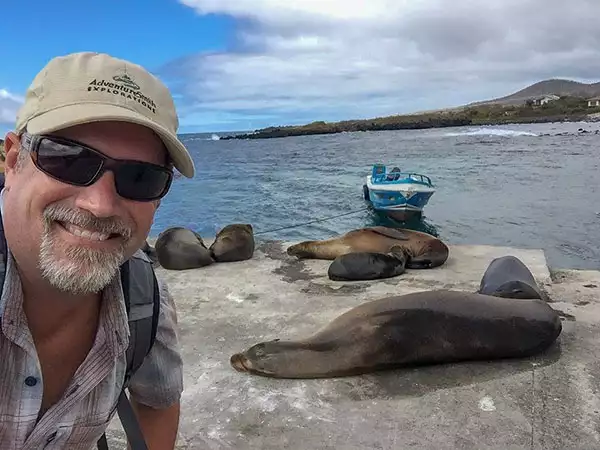
ASK A GALAPAGOS
TRAVEL EXPERT
You’ve got questions.
We’ve got answers.
If you like this guide to the best time to visit Galapagos Islands, you will love our comprehensive travel planning services. Our experts have more information on when to visit Galapagos, planning your Galapagos vacation or the best time of year to visit Galapagos. When you are ready to book the trip of a lifetime, just give us a call, our experts are ready to help.
MORE GALAPAGOS RESOURCES:
Galapagos Trips
Galapagos Luxury Cruises & Tours
Galapagos with Kids
Galapagos Diving
Cruises to the Galapagos Islands
Galapagos Charters
Galapagos Trip Cost Explained
Galapagos Island Hopping or Cruise?
Galapagos Land Tours
How to Get to Galapagos
Galapagos Islands Animals
Galapagos Trip Reviews
Galapagos Travel Guide
Galapagos Cruise Deals
Have a question or looking for advice about the best time to visit Galapagos? Use the comments below and we’ll answer your question and make this guide even better.
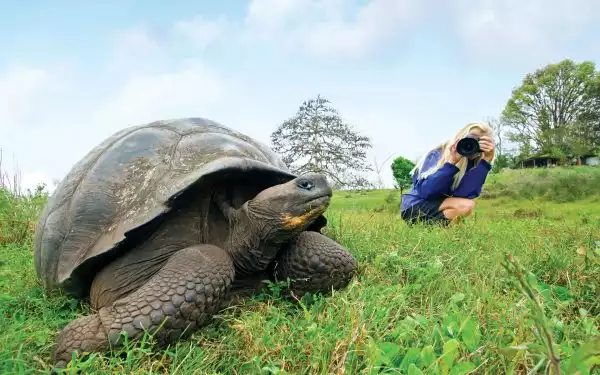
Comments will be moderated and will appear after they have been approved.
confusing I want warm dry season to travel..no showertsnot cool…a group of ecuatoriansotold me April..I had thought it was better DECEMBER but reluctant to wait to much time–so how about MAY? is it dry and warm? to enjoy the beach’
Hello,
Great question. Galapagos has two predominate seasons: warm and rainy or cool and dry. However, the rainy season does not mean constant rain and the dry season still has the mist-like Garua. May is an excellent time to visit, as the seasonal crossover provides the best of both worlds: great weather, ideal ocean conditions, relatively few people and interesting wildlife due to shifting currents/food sources. One of our Galapagos specialists will be in touch soon to talk through these nuances with you.
I am eager to go on trip and am torn between early December and early February. The most important thing to me snorkeling, marine life and visibility, and warm temperatures. Is December full summer season or is there risk it’s too early for good visibility and calmer waters?
Hi Michelle, thanks for your question. Considering your goals, we would advise visiting the Galapagos in February. December is just the beginning of the warm season, early in the month the misty garúa fog is still present. February is known for the best underwater visibility, with hot, humid days and clear, calm warm water. Now that you know the best time to visit Galapagos for you, it’s time to pick your Galapagos cruise. Our experts are here to help and will be in contact shortly.
When is the water in the Galapagos islands the MOST calm and when can you see the most sea turtles, sea lions, penguins, sea turtles, sharks?
Hi Sharon!
For calmer ocean conditions consider traveling during the Galapagos warm season, from December – May. The animals you mention can be spotted all year round but you will want to target specific islands to find penguins. Take a look at our article on Galapagos Islands Animals for info on where, when and how you can find different species. Or contact our experts for recommended itineraries based on your wildlife bucket list.
My husband and I are planning to visit the Galapagos Islands in 2020. We will also visiting Peru/Machu picchu during this trip.
We want to see the courtship rituals of the boobies, the frigate birds, and the waxed albatross flemingo and other wildlife. We would like to travel to different islands.
We are considering either end May/June or Sept. What would be the best time to see the things mentioned above and have the good weather and calm waters.
Thanks very much
Hi Geetha,
The Galapagos Islands have something unique to offer every month of the year, however, May is a great month to meet all of your Galapagos wildlife viewing goals. Spring in the Galapagos typically presents the best weather and calmest water. Be sure to check out our Galapagos Islands Cruise Finder and an Adventure Specialist will be in contact with you soon to discuss the specific itineraries available during this time frame.
Hello,
My girlfriend and I are looking at visiting the galapagos islands during the last week of November or first two weeks of December. (Dates are flexible within that time frame)
Our interests are mainly in Sea life (sharks, rays, sea lions, turtles but would also love to see the Giant Tortoises. The other land highlights would be a bonus but not a must. also the option to scuba dive would be great if possible and worthwhile
Would you have any availability / suggestions for something like the above?
Many thanks,
Dave
Hello Dave,
You are in luck, the sea that surrounds the Galapagos is full of interesting sea life and our Galapagos cruises offer multiple snorkeling opportunities. We can be sure to help you find the ideal trip with lots of time in the water as well as one that introduces you to giant tortoises. A Galapagos specialist will be in touch to discuss your options.
My husband and I would like to visit the Galapagos Islands in 2019. We are free to travel any time. We want to go when we can see the courtship rituals of the boobies, the frigate birds, and the waxed albatross, if that is possible, and of course, see other wildlife. We would like to travel to different islands, but want to be sure to go to Genovesa Island, North Seymour Island, San Cristobal Island, Espanola Island, and Santa Cruz Island. What would be the best time of year to go to these islands to see the things mentioned above and have the good weather ( little rain) and calm seas.
Thank you for your help.
Hello Ruby,
The Galapagos Islands are an excellent destination year round as they only get about 20 inches of annual rainfall. However, spring could be a good time for you as the weather is excellent, the water warmer and waved albatross and blue-footed boobies are in the midst of their courtship rituals. Booking a cruise with a longer itinerary will ensure a wider variety of wildlife, more islands and the more in-depth experience that you are looking for. That said, the best thing about the Galapagos is that no matter where and when you go charismatic megafauna will be close by and something interesting is always happening. Read over our How to Choose Your Galapagos Cruise guide for more information on finding the right trip for you. A Galapagos expert will be in touch with you soon to discuss ship and itinerary options to help you find the trip you are looking for.